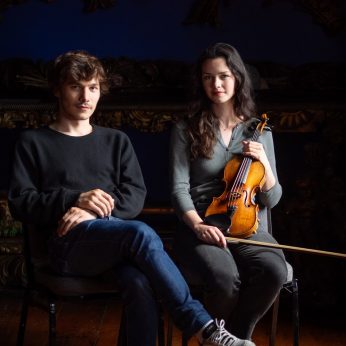Composer: Wolfgang Amadeus Mozart (b. 1756 - d. 1791)
Performance date: 24/06/2023
Venue: St. Brendan’s Church
Composition Year: 1777
Duration: 00:16:40
Recording Engineer: Gar Duffy, RTÉ
Instrumentation: vn, pf
Instrumentation Category:Duo
Artists:
Mairead Hickey -
[violin]
Jérémie Moreau -
[piano]

Violin Sonata No.17 in C major K.296 [1777]
1.Allegro vivace
2.Andante sostenuto
3.Rondo-Allegro
In the summer of 1777 the Salzburg establishment led by the infamous Archbishop Colloredo dismissed both Mozart and his father from their posts. Mozart immediately set off with his mother to look for a more amenable employer. After breaks in Munich and Augsburg, they arrived in Mannheim en route to Paris. Mannheim was one of the most important musical centres in Europe and Mozart set about presenting himself and his astonishing music-making to the Palatinate Court. In the intrigue that followed, Mozart was hopelessly naïve and totally out-manoeuvred by the local musical establishment. In addition the political machinations that eventually led to the War of the Bavarian Succession had captured the attention of the Court, who quickly lost interest in the upstart young pianist-composer.
Mozart was barely twenty-one and it was hardly surprising that he fell in love with a beautiful soprano for whose sake he dallied in Mannheim long after any hope of a prestigious posting had passed. She was Aloysia Weber, older sister of Constanze, whom he eventually married (after Aloysia had rejected him). Mozart surely wrote this Violin Sonata for the lover’s parting when he had eventually to leave for Paris.
During his visit to Munich, Mozart had come across a set of six violin/piano duets with a tight, integrated ensemble by Joseph Schuster. Mozart was sufficiently impressed to set about writing a similar set as he saw how popular they were. Eventually between Mannheim and Paris he wrote seven sonatas, six of which were published in 1778, the one he held back was this C major Sonata, which clearly had special resonance for him. He saved it until 1781 for another set that he published in his new home in Vienna.
An anonymous reviewer wrote in the Hamburg Magazin der Musik in 1783. These sonatas are the only ones of their kind. They are rich in new ideas, showing traces of the great musical genius of their author…. Moreover, the violin accompaniment is so ingeniously combined with the piano part that both instruments are continuously employed; and thus these sonatas demand a violinist as accomplished as the pianist.
This high level partnership is immediately apparent in the delightful give-and-take of the opening movement. The Andante is a gentle love-song, a farewell that looks forward to the lover’s next meeting though there is a hint of uncertainty in the pauses of the coda. All doubt is banished in the dancing rondo Finale.
Francis Humphrys
Copyright © 2025 West Cork Music. All rights reserved.
Designed and developed by Matrix Internet